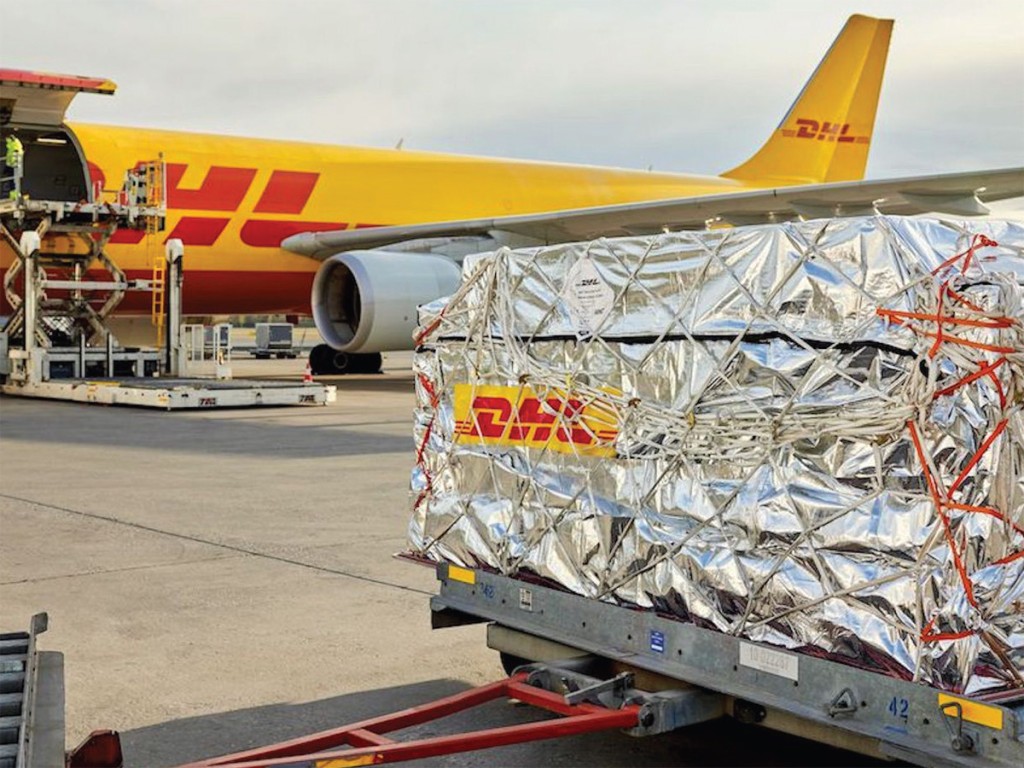Despite its self-described title as the “world’s largest air freight forwarder,” DHL doesn’t rely on self-promotional brute strength to dominate markets globally. The 208-year-old company has built itself into an international transportation powerhouse through low-profile marketing, quietly pouncing on niche opportunities and relying on what might be called aggressive agility.
While DHL’s bright red and yellow logo is familiar to the global logistics world, it’s doubtful that the FED-Ex or UPS user would know DHL is also the undisputed leader in international express shipping of documents and parcels, serving 220 countries and territories.

Pandemic Challenge
However, Patricia A. Cole, global head DHL Same Day and DHL Global Forwarding Temperature Management Solutions, in an exclusive interview with the American Journal of Transportation, said that DHL delivered the vaccine to obscure, virtually unknown locations such as the “tiny, little Comoros Islands off the coast of West Africa.”
But the challenge is more than just dropping off some boxes. “It’s a complex solution when you are dealing with the viability of the vaccine in terms of the number of days the packaging is validated for,” she explains. “You’ve got so many kilos of dry ice which limits the amount of aircraft that you can use.” (For this lift and others, DHL used the Russian-built Antonov AN-26 twin-engine turboprop).
The COVID vaccine assignment, which started in August 2021, is still ongoing, although the volumes are lower.
Although DHL strategically delivered COVID19 vaccine to 120 countries for the pharma client, the company has a reputation for being selective in its commodities and payloads. While it could easily muscle into markets given its size and strength, it chooses to make, again, low-profile moves.

Perishables Market
For example, Miami-based Andreas Von Pohl, senior vice president-air freight for the Americas, told a reporter in 2019 DHL would slowly “make a controlled entry” into the perishables markets. Today, Von Pohl, who spent 25 years in a similar position with giant DB Schenker before joining DHL, says “we are selectively engaging with customers in the perishables space.” The specific commodities, once more, were not identified.
A source close to the airline says DHL’s perishables traffic is strong in Latin America but most of the commodities are exported to Asia.
According to its website, DHL has two “business only” divisions that target high volume business to business shipments, such as retail and technology products. Added to its large express division, the company can address most shipper requests regardless of size.
During the pandemic, Von Pohl told the AJOT, “We served the tech sector with flexibility and agility.” In short, shippers could reach customers and buyers who chose to stay in the office or employees who worked remotely at home using the same air cargo carrier.
The technology sector is thriving for DHL—from laptop and desktop computers to mobile phones, Indeed, consumer demand for personal technology climbed sharply during the pandemic when office workers left their low or high-rise business offices and furnished home offices, many for the first time, according to Von Pohl.
“Suddenly, demand for our services was supercharged on the import side from Europe and China. We had to deploy dedicated freighters to keep up with the demand and supplement our lift with space on Atlas Air, Qatar Airways, Cathay Pacific, and National Airlines among others. We also had to hire and train hundreds of people.”
More recently, the DHL air freight executive says, the “market is trying to normalize itself.” He says demand “fell off” during the first quarter after the prior “surges.” Seaworthy freight that switched to air when ports were congested, and containers were scarce is “converting back to ocean freight.”
Adds Von Pohl: “Consumer demand is scaling back, and volumes are softer, but we see an uptick of new and existing business in the second half of this year.”

Focus Solutions
Still, DHL isn’t just waiting for the growth cycle to return. The company has targeted three industry focus areas or “customer solution initiatives” and invested capital to further grow them in the U.S., he says.
They include capital equipment transportation for the semiconductor industry which is an expanded emphasis on its existing technology sector expertise. Second is chemicals logistics while third is aerospace and airplane parts.
All three initiatives involve movement of high-value, high-yield, time-sensitive cargoes where skilled handling and special warehousing are necessary if not required.
However, it is the life sciences division that has contributed mightily to DHL Global Forwarding’s reputation in recent years and continues to command a lion’s share of its corporate attention and capital. For example, according to Patricia Cole, DHL recently opened a “state of the art,”18,000 square foot Life Sciences certified station with 2 C degree to 8 C degree cooling capability in the Raleigh Durham, North Carolina Research Triangle Park.
The total 38,000 square-foot structure is one of the largest 100 percent temperature-controlled cooler-warehouses of any freight forwarder in the U.S. Southeast region, she asserts, and is the centerpiece of a suite of pharma solutions.
Indeed, DHL as a company, sees strong potential growth in pharma in both new medicines and geographical opportunities. “We’re putting emphasis where it needs to be going forward,” contends Cole. “Clinical trials are not as prevalent in Africa; however, we have built a competency center in Johannesburg with cool rooms, and we are investing a lot of time in training our teams there.”
Cole insists that besides investing in brick and mortar facilities, DHL puts exceptional time in training its life sciences labor force in documented pharma processes and specialized compliance over and above straight logistics.
As a result, DHL’s personnel that works for 200 pharmaceutical companies worldwide, had a “very minimal loss of people” during the pandemic lockdown, contends Cole, and a majority of them were rehired and retrained to get current during the time they were off work.



